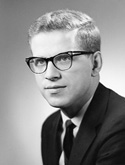Becoming Became
—by Donald G. Balmer, U.G. Dubach Professor Emeritus of Political Science

Author’s Note: Becoming Became is the title of an album and song composed by my son, Dan Balmer ’80. He says it refers to the concept ofkairos, the fullness of time.
I’ve been sifting through my piles of manila files recently. Their contents reflect my more than 50 years with Lewis & Clark and help tell the story of the College’s becoming what it became.
Once Morgan Odell and the trustees refused to let Albany College die a natural death in 1942, they adopted the unlikely goal of making Lewis & Clark a top regional college, one that would rank among the best of the era’s some 35 Presbyterian schools.
Joining the faculty in 1951, I found that Odell had cobbled together a campus of war surplus buildings and a faculty of Albany College stalwarts, retirees, visionaries, and young graduate students. They had made Lewis & Clark “Portland’s college,” serving primarily veterans on the GI Bill®.
During this heady period, I attended Lewis & Clark homecoming parades in downtown Portland, listened with packed crowds to College concerts at the Civic Auditorium, and applauded as Morgan Odell was named Portland’s First Citizen. On campus, students signed up for a six-course general education core based on (Western) civilization and the humanities, which included an introduction to art, music, and the social sciences. Business administration and education were the popular majors.
Students won Wilson Fellowships and Fulbrights, and were accepted at the University of Chicago, Harvard University, Stanford University, and other prestigious schools. By the end of the Odell era, Lewis & Clark had become what it had strived to be.
But the situation was changing. Even as the new Portland State College attracted many local students, Lewis & Clark experienced a demand for residential facilities that exceeded supply. Enter John Howard in 1960, Lewis & Clark’s new president, whose tenure can be described with words such as international, innovative, lively, and open-minded. Under his leadership, the College expanded its residence hall space. When construction delays occurred, students, including first-years, were dispatched to Japan and Mexico with Lewis & Clark faculty. Soon our students and faculty were studying on the other side of the globe—and closer to home in Washington, D.C., and New York City.
During this period, the Western civilization and humanities core was dropped, as was done in most colleges, to be succeeded by experiments with first-year seminars and courses in critical thinking. “Happenings” and “Hootenannies,” protests, and civil rights and peace movements replaced most traditional student activities such as fraternities, sororities, and service clubs. The College loosened its ties with the Presbyterian Church.
To become what we became required increasing enrollment and undertaking many programs. Such openness to innovation meant that not all programs could be well funded or of the quality to which we aspired. Nevertheless, in the 1960s and 1970s the College’s national reputation continued to grow, and our graduates’ career paths led them far beyond the Pacific Northwest.
Had we become all that we could? Michael Mooney, who joined the College in 1989, and his administration said “not yet.” In recent years, I’ve witnessed wonderful changes in the physical campus, along with an increase in endowed scholarships, the creation and funding of named professorships, and generous research support—especially for faculty-student projects. Students have won Rhodes, Truman, Goldwater, and Fulbright scholarships, plus many others. The College now has a Phi Beta Kappa chapter. We are not there yet, but we’re still on our way.
I am reminded of what Daniel Webster said in arguing the Dartmouth College case before the Supreme Court: “It is but a small college, sir, but there are those who love it.” As I take my leave after 50 years, I am overwhelmed by the good fortune of having been one of the thousands who love Lewis & Clark and who have helped it become what it became.
More L&C Magazine Stories
Lewis & Clark Magazine is located in McAfee on the Undergraduate Campus.
MSC: 19
email magazine@lclark.edu
voice 503-768-7970
fax 503-768-7969
The L&C Magazine staff welcomes letters and emails from readers about topics covered in the magazine. Correspondence must include your name and location and may be edited.
Lewis & Clark Magazine
Lewis & Clark
615 S. Palatine Hill Road MSC 19
Portland OR 97219

